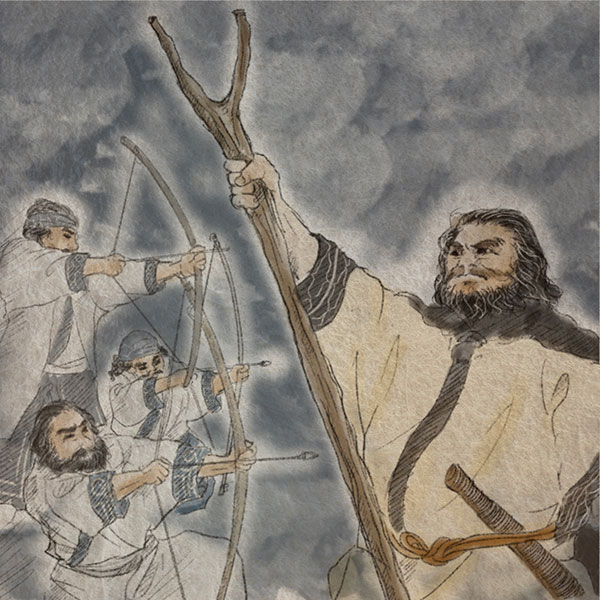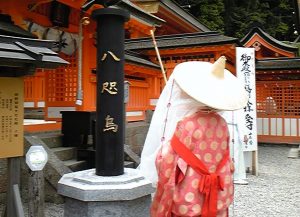Battle of Shakushain (1/2)Battle between the Matsumae clan and the Ainu

Battle of Shakshain
- Article category
- case file
- Incident name
- Battle of Shakushain (1669)
- place
- Hokkaido
- Related castles, temples and shrines

Matsumae Castle
During the Edo period, the Ainu lived in most of Ezo (present-day Hokkaido, Sakhalin Island, the Kuril Islands, etc.), but the Matsumae Domain, established by the Edo Shogunate, gradually strengthened its control over the Ainu, and conflict between the Ainu and the Shogunate deepened. Amid this, the conflict between Ainu tribes escalated into a battle between the Ainu and the Matsumae Domain, with the Battle of Shakushain occurring in June 1699 (9th year of the Kanbun era). The battle, which began with the Ainu rising up in unison at the call of their chief Shakushain, ended with his assassination. In this article, we will provide an easy-to-understand explanation of the Battle of Shakushain.
The Matsumae clan that ruled Ezo during the Edo period
Before we get into the Battle of Shakushain, let's explain the situation in Ezo, especially Hokkaido, during the Edo period. From around the 15th century, conflicts between the Ainu and the Wajin who had migrated to Hokkaido from Honshu had intensified, and skirmishes had broken out.
In 1457, the third year of the Kōshō era, a large-scale battle called the Battle of Koshamain occurred. The battle began when a financial dispute arose between an Ainu man and a Wajin (blacksmith) in Shinosato (Hakodate, Hokkaido), leading to the blacksmith stabbing the Ainu man to death. The Ainu of the eastern part of the Oshima Peninsula, dissatisfied with the rule of the Wajin, staged an armed uprising led by their chief, Koshamain.
The Ainu army was strong and the Japanese were cornered, but thanks to the efforts of Takeda Nobuhiro, a guest general of the Kakizaki clan, the Japanese army won against the Ainu. After Nobuhiro's victory at the Battle of Koshamain, he married the adopted daughter of the Kakizaki clan, inherited the headship of the Kakizaki clan, and united the Japanese in Hokkaido. This Kakizaki clan later became the Matsumae clan.
During the time of Toyotomi Hideyoshi, the Kakizaki clan was granted control of Ezo and Matsumae, and later changed its name to Matsumae and served Tokugawa Ieyasu. In 1604, Tokugawa Ieyasu granted them a "black seal letter" that allowed them to govern Ezo and manage trade with the Ainu.
The reason why the Kuroinjo mentions trade is because the Matsumae clan was not able to grow rice at the time and it was difficult to collect annual taxes in rice. Unlike other clans, the Matsumae clan monopolized trade with the Ainu and secured its financial resources through profits from trade and taxation of commodity distribution.
The Kuroinjo states, "Japanese people cannot go to Ezo and do business without the permission of the Matsumae clan, but the Ainu can go anywhere and do business," and at this point the Edo Shogunate allowed the Ainu to travel freely. At the time, the Ainu traveled and traded over a wide area from Honshu, the Kuril Peninsula, and Sakhalin to the territory of the Morioka Domain (eastern Aomori Prefecture, Iwate Prefecture, and northeastern Akita Prefecture). It was difficult for the newly established Matsumae Domain to regulate this.
Japanese people threatening the Ainu way of life
The Matsumae clan separated the land of the Japanese from that of the Ainu, and limited trading areas to the Matsumae castle town. It ordered that all trade with the Ainu be conducted through the Matsumae clan. After that, trade was carried out in specific areas called "trading posts" or "basho" (trading post territory) that were built along the coasts of Hokkaido (trading post chigyo system).
Trading sites were assigned to high-ranking vassals, and samurai or their servants traded with the Ainu at the trading sites, with the profits becoming income for the feudal lord. However, increasingly more merchants took over trading on their behalf, and by the first half of the 18th century, most samurai in charge of trading sites had transferred their trading rights to merchants, shifting to a "place contract system" in which they themselves only received shipping fees.
With the establishment of trading areas, the Ainu were no longer able to trade freely. In some trading areas, trade was conducted under unfavorable conditions for the Ainu. For example, the Ainu were previously trading 100 dried salmon for 2 to of rice, but now the price was reduced to 0.7 to 0.8 to of rice. In this way, the Matsumae clan sometimes offered low prices for the salmon, trout, and herring that the Ainu had caught. In some cases, the Ainu were threatened with the use of children as hostages, and the Ainu suffered continuous hardships. Forced into unfair trade, the Ainu's dissatisfaction gradually grew.
Additionally, the Matsumae domain became known as a famous hawk-producing area, with many feudal lords seeking hawks. During the Edo period, falconry was encouraged by the shogunate as an important form of military training. The Matsumae domain's hawks are famous and have been loved since the time of Tokugawa Ieyasu. Many feudal lords sought out the Matsumae domain's hawks, which could be called "brand hawks," and falconers trying to capture them began to disrupt the Ainu hunting grounds. During the Kanbun era (1661-1673), it is said that there were more than 300 falconry grounds for capturing hawks.
In 1617, gold dust was mined in Lake Soko (Fukushima Town, Matsumae County, Hokkaido) and Osawa (Matsumae Town, Matsumae County, Hokkaido) under Matsumae Castle, and the number of gold dust mining sites rapidly increased. A gold rush occurred in Hokkaido. As depicted in the classic Ainu-focused manga Golden Kamuy, the gold rush led to the invitation of many Japanese people from Honshu, who caused problems for the Ainu. The salmon and trout populations drastically decreased due to the destruction of rivers caused by gold dust mining, the fishing grounds of the Ainu people were destroyed, and their livelihoods were threatened.
The Battle of Shakushain 1. The trigger was a conflict within the Ainu people
The Shakushain Battle occurred amid deepening conflict between the Japanese and the Ainu, but its original trigger was conflict between tribes within the Ainu people. At the time, the Ainu were not a monolithic group, but consisted of many different tribes, and they were in conflict over hunting and fishing rights.
In particular, the ethnic groups "Menashikuru" from the Shibechari region (Shizunai, Shinhidaka Town, Hokkaido) and "Shumukuru" from the Hae region (Monbetsu, Hidaka Town, Hokkaido) have been fighting since the 17th century. In addition to fishing and hunting rights, cultural differences including the myths and legends passed down by each group also seem to have been a cause of the conflict. The chief of the Menashikuru was named "Shakushain" and the chief of the Shumukuru was named "Onibishi".
According to the "Tsugaru Ichitoitsu-shi," in 1648, at a drinking party held by Kamokutain, the chief of Menashikuru, and Onibishi, Shakushain, who was a subordinate of Kamokutain at the time, killed one of Onibishi's subordinates. Onibishi demanded a gift in exchange for his death, but Shakushain refused, and the conflict between the two tribes intensified. In 1653, Kamokutain was killed in battle instigated by Onibishi. Shakushain succeeded him as chief of Menashikuru.
The fighting between the two tribes was later halted through mediation by the Matsumae clan, which feared an interruption to trade and gold dust mining. However, during the Kanbun era (1661-1673), conflict flared up again over hunting and fishing rights and trading zones. In 1668 (8th year of the Kanbun era), Shakushain ambushed Onibishi while he was visiting the mansion of the owner of a gold dust mine on the Shibechari River, and Onibishi was killed. It is also said that behind the conflict between the two was a dispute over interests between the Japanese. The Japanese, who wanted to advance gold dust mining on the Shibechari River, resented Shakushain, who was opposed to gold dust mining, and lent a hand to Onibishi.
After Onibishi's death, the Shumukuru side was at a disadvantage. They asked the Matsumae clan to lend them food and weapons, but the Matsumae clan refused. The Matsumae clan was in a position to mediate between the two tribes and could not side with either side. There was also the risk that if the Matsumae clan's guns were handed over to the Ainu, it would lead to a rebellion by the Ainu. If the two tribes fought and became weaker, it would be easier for the Matsumae clan to rule. That was the thinking.
However, the Shumukuru side did not give up. In 1669, Utaf (also known as Utofu or Utomasa) of Saru, who was related to Onibishi, again asked the Matsumae clan for help, but the Matsumae clan maintained their position of arbitration.
Utaf's death from illness on his way home was a major cause of the Battle of Shakushain. The cause of death was smallpox, but rumors spread that he had been poisoned by the Matsumae clan. The Ainu, who had been growing resentment towards the Japanese, responded one after another to Shakushain's appeal to "defeat the Matsumae clan before we are poisoned to death."
Battle of Shakushain 2. Battle of Khunnui River
With Utaf's death as a trigger, Shakushain issues a rousing speech to the Ainu, saying, "The Matsumae clan is trying to wipe out the Ainu. Their food has been poisoned, and Utaf died from it. The Ainu must rise up before they are poisoned to death." The contents of the speech vary depending on the source, but Shakushain's idea seems to have been to invade Matsumae, destroy the Matsumae clan, and then allow the Ainu to trade freely. The Ainu responded to this call and began attacking the Japanese one after another.

- WriterNaoko Kurimoto(Writer)I am a former travel industry magazine reporter. I have loved history, both Japanese and world history, since I was a child. I usually enjoy visiting temples and shrines, especially shrines, and often do ``pilgrimages to sacred places'' themed around historical figures. My favorite military commander is Ishida Mitsunari, my favorite castle is Kumamoto Castle, and my favorite castle ruins is Hagi Castle. My heart flutters when I see the ruins of battle castles and the stone walls of castle ruins.



